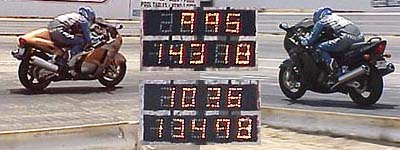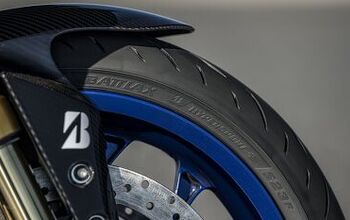Church of MO: 1999 Top Speed Shootout
1999 Top Speed Shootout
Birds of Prey
July 6, 1999, Los AngelesIt may be too distinct looking for a few of the combed-over (or soon to be combed-over), middle-aged white guys who comprise much of the motorcycle industry — as well as a few consumers. But for the girls cruising the Sunset Strip, it’s the bomb.
“What kind of bike is that?” shouted a hottie from the passenger side of her equally-as-hot friend’s red Boxster while sitting at a stoplight on Los Angeles’ Westside.
“It’s a Suzuki,” our editor answered, yelling through his half-opened full-faced lid. “It’s the new Hayabusa.”
“Hey-yah-what?”
“Hi-ah-boo-sah. It’s a Japanese Falcon.”
“How fast does it go?” Even the uninitiated understand that Suzuki created the Hayabusawith one overriding purpose in life.
“About 190 miles per hour, if you’ve got the $*&%# to do it.”
“That’s too fast!” The hotties squealed in unison and giggled in delight. Fast is dangerous, dangerous is thrilling, thrilling is powerful and powerful is sexy… or something like that.
When the light turned green, the girls flew away while we were temporarily grounded behind blue-haired tourists in a Chevy Geo. It was soon clear that we would not share a mad dash into the soft luminescence of the Hollywood twilight, and the hotties waved good-bye, flashing Ultra-Brite smiles and two thumbs up, Siskel and Eberts of the cognoscenti, only of the opposite sex and, of course, way, way hotter.
The Suzuki GSX-1300R, labeled the Haya-Bubba by a few of the Netizens who lurk around MO‘s BBS boards, is, to some, odd and bulbous, fat and ugly. In fact, in our recent survey, only much-maligned Monica Lewinsky beat out the ‘Busa on the ugly scale. However, except for the R-series Yamahas and, to a lesser degree, the Honda VFR800, no Japanese sportbike we have ever ridden has so consistently aroused the primal desires among potential mating partners as the Hayabusa.
For that alone, we would hand over the Top Speed Crown without even upshifting from fourth gear. But it’s more than that. The Hayabusa is a blast to ride. Of course it’s not as light as the R1 or the ZX-9R, but for a 1300cc motorcycle, it’s more than nimble enough. It’s not as refined as the Blackbird, but it’s certainly not primitive. And it’s fast. Too fast.
1999 Honda CBR1100XX Blackbird
Pity the poor Blackbird. Until recently the Dos Equis was the fastest production motorcycle made, but this year, despite a few significant performance upgrades, the Blackbird has been relegated as the second-fastest motorcycle. Even so, the Blackbird offers much to an owner, including refinement, comfort and typical Honda reliability. Also, it’s fast enough that if the Highway Patrol catches you, you’ll run a good chance of losing the bike along with your driver’s license. (Just ask Managing Editor Cool Hand Mark.) From the outside the only way to tell the difference between a 1998 and a 1999 XX is by looking at the redesigned tail light and the newly positioned ram-air duct screens.
Significant changes have been made to the XX, but they hide beneath the tasteful, yet somewhat bland, black bodywork. Power, particularly mid-range, has been improved by redesigning the ram-air intake ducts, adapting the VFR800’s Digital Electronic Fuel Injection System (which also eliminated the need of a choke lever), differentiating the lengths of two of the four velocity stacks and using 3-D maps for throttle position, ignition timing and intake pressure.
Honda has also developed a “knock sensor” that adjusts spark advance while minimizing knock and improving mid-range, particularly in the 3000 – 6000 rpm zone where many riders reside, especially on the open road. This mid-range power boost is noticeable during long-distance sport touring.
“At 6000 rpm in sixth gear the XX cruises along at a registered 95 miles per hour, fast enough to ignite the ass hairs of your local jurisdiction’s finest.”
Slow down to a more modest 80 mph, still above the speed limits but slow enough to satisfy all but the I-have-to-get-my-quota patrol officers, and the XX pulls along comfortably. As a sport tourer the Blackbird excels in all areas except one — comfort.
The linked braking system, adapted from the VFR800, is excellent, and although more experienced riders often prefer separate brake controls to a linked or ABS system, we thought XX’s LBS provided better feel than the Suzuki’s dual front six-pots. A dual-shift balancer — the engine counterbalancer — minimizes vibrations to almost undetectable levels. Honda, noted for smooth trannies, has equipped the XX with a hard-rubber transmission damper that makes downshifts into neutral even smoother.
“While it’s not the most comfortable bike for long distance, highway-oriented sport touring, the XX is wonderful for long, holiday weekend sprints.”
The seat is comfortable, particularly for stock, and the reach to the handlebars is civilized. The fairing provides excellent wind protection, although the windscreen could be a little higher. In short, the ‘Bird is, by far, the smoother ride.
Hey, MO! That sounds great, so what’s the beef? Well, the footpegs are set relatively high, cramping the legs of riders over 5′ 10″. In addition, the footpegs have ridiculously long feelers, something that seems to be becoming a Honda trademark. The footpegs should be a little lower since the vast majority of owners will use the XX as a high-speed, sport-touring weapon rather than a track or canyon-scratching bike. Our Managing Editor, on his fateful trip from Los Angeles to El Paso, Texas, cursed the footpeg position on an almost hourly basis. At six feet tall and in his mid-thirties, he was good for about 100 miles before the leg cramps began to burn. However, the touring range of the XX is about 150 miles (at about 85 mph with little head wind) and the gas mileage on the open highway averaged 33.8 miles-per-gallon for the trip. Still, it all worked out because between 100 and 120 miles, depending on the severity of his leg cramps, the XX was ready for a refueling and Hammond’s legs were ready for a good stretch.
While it’s not the most comfortable bike for long distance, highway-oriented sport touring, the XX is wonderful for long, holiday weekend sprints. Its long seat and relatively low-set mufflers make it ideal for carrying a good set of soft luggage. It’s also one of the best sportbikes made for two-up riding. The passenger feels comfortable and the driver feels confident, and, as a two-up blaster, the XX takes to the road with aplomb. It’s also a terrific commuter, Marketing Manager Greg McClure time and time again chose the XX over other bikes in our stable, such as the YZF-R6, the Hayabusa and the Ducati ST4, for his daily 100-mile adventure on the I-405 from Newport Beach to Marina del Rey and back. Its excellent mid-range performance, neutral handling, and almost vibration-free power train makes the XX an almost ideal commuter.
The rigid, aluminum-alloy twin-spar chassis keeps everything tight and the stock suspension of the XX is great for most street riding situations. However, you are out of luck if you want to tweak the chassis because it’s non-adjustable. Also, the XX is a little heavy for a sportbike, and while it was easier to ride in the twisties than we initially expected, it isn’t exactly a 600 Supersport. Overall it’s a little too heavy (despite the many weight-saving devices Honda has incorporated, such as lighter levers and footpegs and new aluminum cartridge rods for the front fork) if your primary milieu is the canyons.
The XX is a highly refined motorcycle, a bit like James Bond: well-mannered, well-groomed, slick yet willing to deliver a serious ass-kicking when asked, producing a whopping 139 horsepower and running a 10.38 quarter mile at 134.98 miles per hour in the high desert at Los Angeles County Raceway. For a bike this powerful the quarter-mile time might seem anemic, but we blame the harder-compound Dunlop street tires and the light, yet very grabby clutch for the XX’s underwhelming performance.
Not every change or “upgrade” is necessarily an improvement and while it’s strong, the grabby clutch was particularly noticeable at the dragstrip, where Graves Motorsports AMA Formula Xtreme and 600 Supersport rider Paul Harrell had difficulty maintaining smooth, progressive launches. Better tires and a more linear clutch engagement could have shaved, at the very least, 0.1 to 0.2 seconds from quarter-mile times.
More by John Burns


































Comments
Join the conversation
Blackbird was a lovely motorcycle. Miss it.
Since seeing the Stratosphere, I had always hoped that the Hayabusa would morph into something similar. And yet it still looks like it's having an allergic reaction to a bee sting.